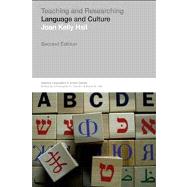
Teaching and Researching: Language and Culture
by Kelly Hall; JoanBuy New
Rent Textbook
Rent Digital
Used Textbook
We're Sorry
Sold Out
How Marketplace Works:
- This item is offered by an independent seller and not shipped from our warehouse
- Item details like edition and cover design may differ from our description; see seller's comments before ordering.
- Sellers much confirm and ship within two business days; otherwise, the order will be cancelled and refunded.
- Marketplace purchases cannot be returned to eCampus.com. Contact the seller directly for inquiries; if no response within two days, contact customer service.
- Additional shipping costs apply to Marketplace purchases. Review shipping costs at checkout.
Summary
Author Biography
Joan Kelly Hall is Professor of Applied Linguistics in the Department of Applied Linguistics at the Pennsylvania State University. Her recent books include Interactional Competence and Development (with J. Hellermann and S. Pekarek Doehler, 2011) and Dialogue with Bakhtin on Second and Foreign Language Learning (with G. Vitanova and L. Marchenkova, 2003).
Table of Contents
INTRODUCTION
SECTION 1 DEFINING LANGUAGE AND CULTURE
Chapter One A sociocultural perspective on language and culture
1.1 Introduction
1.2 Language as sociocultural resource
1.2.1 Dialogue as the essence of language use
1.2.2 Single- and double-voiced utterances
1.3 Culture as sociocultural practice
1.4 Linguistic relativity
1.5 A socially constituted linguistics
1.5.1 A socially constituted approach to the study of language and culture
1.5.2 The recent turn in studies of communicative activities
1.5.3 From linguistic relativity to sociolinguistic relativity
1.6 Systemic functional linguistics
1.7 Summary
Further reading
Chapter Two Language and identity
2.1 Introduction
2.2 Social identity
2.2.1 Contextual relevancy of social identity
2.3 Agency, identity and language use
2.3.1 Giddens’ theory of structuration
2.3.2 Bourdieu’s notion of habitus
2.4 Research on language use and identity
2.4.1 Interactional sociolinguistics
2.4.2 Co-construction of identity
2.5 Summary
Further reading
Chapter Three Language-and-culture learning
3.1 Introduction
3.2 A sociocultural perspective on language and culture learning
3.2.1 Mediational means
3.3 Language socialisation
3.4 Learning how to mean
3.5 Social activity and language development
3.6 Social activity and cognitive development
3.7 Contexts of learning
3.7.1 Language classrooms as fundamental sites of learning
3.7.2 Learning beyond the traditional classroom
3.7.3 The effects of globalization on sites of learning
3.8 Summary
Further reading
SECTION 2 TEACHING LANGUAGE AND CULTURE
Chapter Four The sociocultural worlds of learners
4.1 Introduction
4.2 Language socialisation practices: Home and school connections
4.3 Language variation
4.4 Redesigning curriculum and instruction
4.4.1 Culturally responsive educational programmes
4.4.2 Funds of knowledge
4.4.3 Language awareness curricula
4.5 Summary
Further reading
Chapter Five Language and culture of the classroom
5.1 Introduction
5.2 Schools and classrooms as sociocultural communities
5.3 The role of classroom discourse
5.3.1 The The dominant pattern of interaction in classrooms
5.3.2 Changes in the third-turn that enhance learning opportunities
5.3.3 Social dimensions of classroom discourse
5.4 Redesigning curriculum and instruction
5.4.1 Communities of learners
5.4.1.1 Communities of practice
5.4.1.2 Key design principles in creating a community of learners
5.4.1.3 Classrooms as communities of inquiry
5.4.2 Cooperative learning practices
5.4.2.1 Components of cooperative learning practices
5.5 Summary
Further reading
Chapter Six Language and culture as curricular content
6.1 Introduction
6.2 Defining knowledge of language and culture
6.2.1 Communicative competence
6.2.2 Interactional competence
6.2.3 Communicative competence revisited
6.2.4 Intercultural communicative competence
6.2.5 Learning outcomes: Where are we going?
6.3 Pedagogical approaches for redesigning language classrooms
6.3.1 Critical pedagogy
6.3.1.1Problem-posing approach
6.3.2 Project-based learning
6.3.2.1 Pragmatic ethnography
6.3.3 The multiliteracies project
6.3.3.1 Genre-based pedagogy
6.4 Summary
Further reading
SECTION 3 RESEARCHING LANGUAGE AND CULTURE
Chapter Seven The research enterprise
7.1 Introduction
7.2 Foundations of research on language and culture from a sociocultural perspective
7.3. Methodological considerations
7.3.1 Choice of methods
7.3.2 Transcription issues
7.4 Negotiating relationships
7.5 Research ethics
7.6 Summary
Further reading
Chapter Eight Approaches to research on language and Culture
8.1 Introduction
8.2 Ethnography of communication
8.3 Interactional sociolinguistics
8.4 Conversation analysis
8.5 Discourse analysis
8.6 Systemic functional linguistics
8.7 Critical discourse analysis
8.8 Linguistic ethnography
8.9 Microgenetic approach
8.10 Summary
Chapter Nine Guidelines for doing research
9.1 Introduction
9.2 The research cycle
9.2.1 Identifying concerns and developing research questions
9.2.1.1 Negotiating access and relationships
9.2.2 Identifying research approach and sources of data
9.2.2.1 (Participant) observations and fieldnotes
9.2.2.2 Video-recordingsand other visual materials
9.2.2.3 Interviews and questionnaires
9.2.2.4 Focus groups
9.2.2.5 Verbal protocols
9.2.2.6 Personal reflection journals
9.2.2.7 Archives and other documents
9.2.3 Collecting data
9.2.4 Analysing the data
9.2.5 Reflecting on the findings
9.2.6 Sharing findings and taking action where appropriate
9.3 Summary
Further reading
Chapter Ten Contexts of research
10.1 Introduction
10.2 Contexts of research
10.2.1 Macro social structures
10.2.1.1 Suggestions for research projects
10.2.2 Institutional contexts
10.2.2.1 Suggestions for research projects
10.2.3 Communicative activities
10.2.3.1 Suggestions for research projects
10.2.4 Individual experiences
10.2.4.1 Suggestions for research projects
10.3 Summary
Chapter Eleven Resources for teaching and researching language and culture
11.1 Introduction
11.2 Journals
11.3 Professional organizations
11.4 Web-based resources
Glossary
References
An electronic version of this book is available through VitalSource.
This book is viewable on PC, Mac, iPhone, iPad, iPod Touch, and most smartphones.
By purchasing, you will be able to view this book online, as well as download it, for the chosen number of days.
Digital License
You are licensing a digital product for a set duration. Durations are set forth in the product description, with "Lifetime" typically meaning five (5) years of online access and permanent download to a supported device. All licenses are non-transferable.
More details can be found here.
A downloadable version of this book is available through the eCampus Reader or compatible Adobe readers.
Applications are available on iOS, Android, PC, Mac, and Windows Mobile platforms.
Please view the compatibility matrix prior to purchase.
